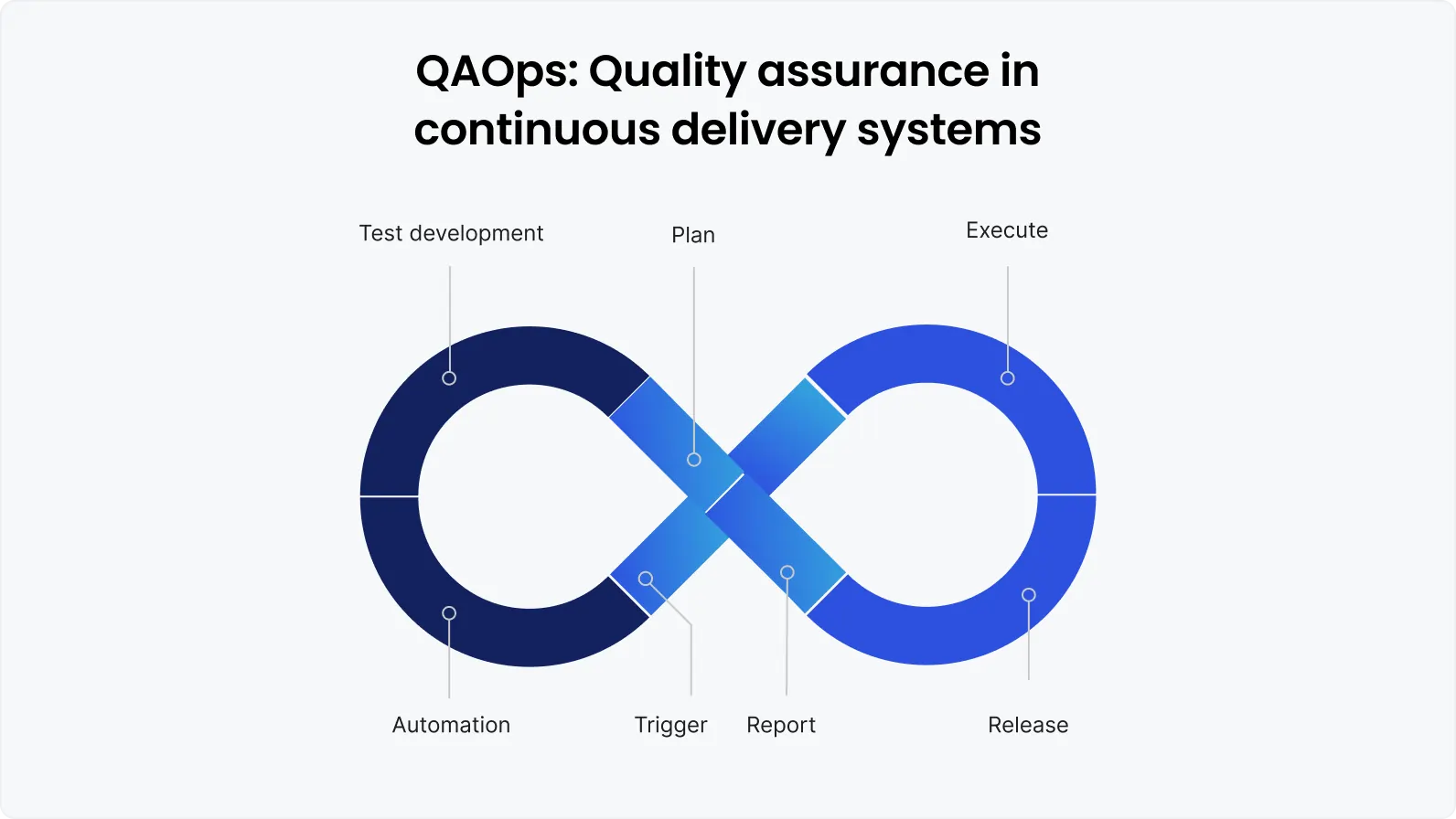15 minutes to read
What is QAOps? Comprehensive guide


Mykhailo Ralduhin
Senior QA Engineer

QAOps (Quality Assurance Operations) integrates QA processes with DevOps practices to enhance software quality and delivery speed.
Ensuring high-quality releases while maintaining rapid delivery cycles is a significant challenge. Implementing QAOps overcomes this challenge by embedding QA processes into the continuous integration/continuous deployment (CI/CD) pipeline. This move detects potential issues in the early stages, allows for continuous testing, and speeds up feedback loops.
Traditionally, QA was a siloed function, often seen as a bottleneck in the development process (we all remember that meme with dinosaurs, innit?) Yet, the rise of DevOps, with its emphasis on collaboration and automation sparked a shift.
And the impact on software quality was substantial. The 2023 State of Quality Assurance report revealed that companies adopting QAOps practices early in the SDLC save over 79% of the budget.
As software development continues to evolve, so do QAOps tools and frameworks. That’s why we release this article — to help you stay ahead in the competitive market. Scroll to dive deeper.
The basics of QAOps
QAOps, or Quality Assurance Operations, combines QA (Quality Assurance) with DevOps (Development and Operations) to ensure the software is high-quality and delivered quickly.
Have you ever made a cake? Similar story (in a metaphorical way, of course): you don’t just check if the cake is good after it’s baked. Instead, you taste and test the batter at every step to make sure it turns out great.
The old way of testing software was like waiting until the cake was fully baked before tasting it. If it didn’t turn out well, you’d have to start over. Overwhelming enough. One of the main benefits of QAOps is that it lets us test early and often, catching problems sooner and fixing them faster.
Fast releases with confidence. Powered by QAOps
Key components
Continuous testing
This is the heart of QAOps, a strategic approach to executing automated tests throughout the software delivery pipeline. These tests run automatically every time a new code is added. Automated testing increases software robustness and speeds up delivery.
Beyond the mere automation of test cases, it encompasses a sophisticated orchestration of testing activities aligned with development iterations. Effective continuous testing necessitates a robust test automation framework capable of handling diverse test types (unit, integration, API, UI, performance) across multiple environments. We should also make a point that it requires meticulous test data management to ensure test environment fidelity and data privacy.
Capgemini found that continuous testing can reduce the time to market by up to 30% and reduce defects by the same 30%.
Shift-left testing, an integral component of continuous testing, emphasizes early defect prevention. If you look to reduce downstream costs and improve general product quality, incorporate testing activities into the early stages of development. To find out more, investigate test-driven development (TDD) and behavior-driven development (BDD) and run through our other comprehensive material.
Collaboration
QAOps implies QA and DevOps teams work together closely, sharing insights and feedback to improve the software continuously. And here, a shared understanding of quality goals, metrics, and processes comes to the frontline.
To find a strong foundation, apply Agile methodologies with their emphasis on cross-functional teams and iterative development. Therefore, among other important aspects, it’s crucial to cultivate a culture of trust, respect, and shared ownership.
Feedback loops
Quick feedback helps developers understand what’s working and what’s not, so they can make necessary adjustments promptly. QAOps demands a sophisticated feedback loop mechanism that encompasses not only defect reporting but also performance metrics, security vulnerabilities, and customer insights. For this reason, try Jenkins, CircleCI, or GitLab CI/CD, popular tools for processing and analyzing feedback.
Predictive analytics can be employed to anticipate potential quality issues and proactively address them. In the mentioned study by Capgemini, 42% of respondents said they are already using AI for this reason. However, it's crucial to remember that data is only valuable when it's acted upon. A closed-loop feedback system ensures that insights are translated into concrete actions to enhance product quality.
Why QAOps matters
Aligning CI/CD and QAOps with the rapid pace of the tech field delivers a potent combination of benefits that drive business development and cultural transformation.
Enhanced quality
Sometimes, we strive for improvement in a too-sophisticated way while the fastest (but not easiest) way is under our nose. To improve software quality, it’s essential to make testing more frequent: QAOps takes each stage of development and enriches it with continuous testing.
Proactive quality assurance: It’s unnecessary to wait for the complete software product to start testing. It’s even unnecessary to reactively fix bugs after they arise. With QAOps, you move from reactive defect fixing to proactive prevention.
Risk mitigation and business continuity: Rigorous testing and vulnerability assessment, integral to QAOps, act as a bulwark against system failures, data breaches, and financial losses. This proactive approach ensures business continuity and protects the organization's reputation.
Customer centricity: Customer is king. When you deeply understand their needs and expectations, you can align quality efforts with customer satisfaction metrics, and organizations can deliver products that truly resonate with the target audience.
Reports and Data source survey states that 21% of QA specialists significantly sped up code release by leveraging continuous testing and integration.
Faster time-to-market
Implementing QAOps accelerates the delivery cycle. If testing processes are integrated into the CI/CD pipeline, this eliminates the traditional bottlenecks associated with separate testing phases. In turn, this streamlined approach enables faster feedback and quicker iterations.
Accelerate State of DevOps found that high-performing companies benefitting from QAOps, deploy 46 times more frequently and have a 440 times faster lead time from commit to deploy. Recall the competitiveness of your market. This is a great advantage, hands down.
Improved collaboration
Team integration: QAOps fosters collaboration and shared responsibility for quality among all team members.
Seamless communication: Developers, testers, and operations staff work closely together, sharing insights and feedback.
Proactive quality assurance: Encourages a proactive approach to quality, with collective identification and addressing of potential issues.
Team efficiency: Effective communication and teamwork reduce miscommunication risks and enhance overall project efficiency.
Scalability
Sooner or later, you will grow. And QAOps allows you to scale testing processes and adapt accordingly. Traditional QA methods often struggle to keep up with the rapid pace and increasing complexity of modern software development.
But the essence of QAOps is automated and continuous testing so that you can scale and meet these demands more easily. By the way, consider Selenium testing or TestComplete to enable this scalability alongside extensive test coverage and efficient management.
Implementing QAOps
This step requires a fundamental shift that goes beyond just technical solutions. First and foremost is a matter of culture. The time of the siloed approach is long gone. Instead, there is a shared ownership of quality among development, QA, and operations teams.
Cultural shift
Specifically about a cultural shift. Your goal as a top executive is to foster a collaborative culture between QA and DevOps teams. Unless quality is a shared responsibility and all team members work towards the same goal, you can’t deliver high-quality software quickly and efficiently.
For instance, Etsy is a prime example of a company that successfully integrated QAOps into their culture. They fostered a collaborative environment where developers, QA engineers, and operations teams work closely.
Automation tools and frameworks
If you can automate a test, automate it. It’s a cornerstone of QAOps and robust software at all. Here are some of the popular tools and frameworks for help:
Jenkins: An open-source automation server that helps automate the parts of software development. It can trigger builds, tests, and deployments based on code changes, enabling continuous testing. Jenkins integrates well with various tools and can be used to set up complex CI/CD pipelines.
Selenium: A powerful tool for automating web applications. It supports multiple programming languages and browsers, making it a versatile choice for automated functional testing.
Docker: A platform that uses containerization to ensure that software runs consistently across different environments. It’s particularly useful in QAOps for creating isolated test environments that mimic production setups.
Beyond these, consider other helpful tools for:
Test management: For organizing and managing test cases (e.g., TestRail, Zephyr).
Performance testing: For measuring application performance (e.g., JMeter, LoadRunner).
API testing: For validating APIs (e.g., Postman, Swagger).
Mobile testing: For testing mobile applications (e.g., Appium, Calabash).
Continuous integration/continuous deployment (CI/CD)

One of the roles of QAOps is to integrate testing into every stage of the software development lifecycle. With this move every team can benefit from:
Early bug detection: Persistent testing detects bugs in early stages and reduces the risk of unexpected critical issues later.
Improved quality: Continuous deployment ensures that only thoroughly tested code is released, maintaining high software quality.
Faster feedback: Another significant benefit is immediate feedback on code quality: if devs smell rat about code quality, they can address any issues promptly.
| Some tips from DeviQA experts | Potential roadblocks |
|---|---|
| Optimize test suite execution: Run the most critical test cases first. This approach minimizes the feedback loop adding up to early identification of critical issues. | Test flakiness: Implement robust test design, isolation techniques, and environment management to reduce test flakiness. |
| Parallel testing: Run multiple tests simultaneously. This significantly speeds up the testing process. Selenium Grid can help distribute tests across multiple environments. | Test maintenance: Prioritize test automation maintenance and refactor tests regularly to prevent test failures. |
| Infrastructure as code (IaC): Implement IaC to manage your testing environments. Terraform and Ansible can automate the provisioning of consistent testing environments, reducing setup time and environment-related issues. | Toolchain complexity: Carefully select and integrate tools to avoid creating a complex and difficult-to-manage ecosystem. |
| Rollback strategies: Ensure you will be able to roll back your deployments. This ensures that if a deployment fails, the system can quickly revert to a stable state, minimizing downtime and impact on users. | Tool compatibility: Ensure that the tools you choose are compatible with your existing infrastructure. |
| Canary releases: Deploy changes to a small subset of users before a full rollout. This strategy helps in identifying issues in a real-world scenario with minimal impact. | Skill gaps: Provide adequate training to your team to handle new tools and processes. |
| Resistance to change: Foster a culture of continuous improvement to overcome resistance to new methodologies. |
Monitoring and metrics
Effective monitoring helps teams identify areas for improvement and track the progress of their testing efforts. Let’s list some important metrics to track.
Test coverage: Measures the percentage of code covered by tests.
Defect density: Tracks the number of defects found in a specific amount of code.
Mean time to detection (MTTD): Measures the average time taken to detect a defect.
Mean time to resolution (MTTR): Tracks the average time taken to resolve a defect and indicates the effectiveness of the issue resolution process.
Success stories: Two useful cases of QA and DevOps integration
1/ Netflix
Challenge: As of 2016, Netflix had subscribers in over 180 countries which made them one of the most trafficked platforms. Nothing groundbreaking that they headed challenges in ensuring the quality of its streaming service. The company needed a robust QA strategy to maintain high performance and user satisfaction. In this case, we can’t even mention the traditional approach. A culture of continuous innovation forces the company to choose top-notch approaches.
QAOps strategy: Netflix teamed up with Simform and adopted QAOps by integrating continuous testing and automation into its DevOps pipeline. They developed their own tools, Chaos Monkey and Simian Army. They aimed to test the company’s resilience to inevitable failures and detect abnormal conditions.
Results: Netflix has implemented a cloud-native architecture driven by microservices within its Virtual Machine (VM) environment. This setup is exceptionally resilient, ensuring high availability and robustness. With integrated Continuous Integration and Continuous Deployment (CI/CD) capabilities, updates and new features can be developed, tested, and launched rapidly and reliably. They designed the architecture to be elastically scalable. Basically, this means it can seamlessly adjust to changing demands by scaling resources up or down as needed.
By eliminating single points of failure (SPoFs), the system minimizes risks associated with any one component failing. Essentially, if one part of the system fails, the rest can continue functioning without a hitch. This is achieved through having small, manageable software components — a principle of microservices architecture. Each component can be updated, maintained, or fixed independently, which simplifies management and enhances system stability.
The quality of the streaming service improved, resulting in a better user experience. The company also saw a reduction in critical bugs, enhancing overall system stability.
2/ Etsy
Challenge: There was a time when all deployment processes at Etsy were manual and lacked automated testing despite the platform’s boast of 2.8 million sellers. Quite logically, they experienced frequent downtimes. As the development and operations teams operated independently they faced prolonged release cycles due to poor communication and misunderstandings. The company needed to ensure that new features and updates did not introduce bugs or degrade performance, especially during peak shopping seasons.
QAOps strategy: The first operational step was integrating automated testing and continuous integration into its development process. The start pack of tools included Jenkins for CI/CD, TestRail for test management, and Selenium for automated testing.
Results: The adoption of QAOps enabled Etsy to significantly reduce its deployment time while lowering the compute cost by 42%. Their collaboration culture deserves separate praise word because engineers were available even at 3 AM during the scheduled migration from the on-premises data centers to Google Cloud. And of course, they significantly improved their test coverage. Must-have though.
Future of QAOps
The future of QAOps is shaped by rapidly advancing technologies and evolving industry practices. Two of the most significant emerging trends are the integration of Artificial Intelligence (AI) and Machine Learning (ML) in testing.
1/ AI/ML in testing: AI-driven test automation tools intelligently generate test cases, identify bugs, and predict potential problem areas before they manifest. For instance, Applitools uses AI-powered visual testing to detect UI anomalies that might be missed by traditional testing methods.
In turn, ML algorithms analyze past testing data to predict where defects are most likely to occur, helping to prioritize testing efforts. ML also identifies redundant or less critical tests and optimizes test suites to speed up the testing process. Testim, for example, leverages machine learning to improve the stability and reliability of test automation.
Machines for machines: Uber’s case. A well-known car-on-demand company has embraced AI and ML in its QAOps practices. They monitor real-time data and predict system failures through AI, which allows their team to address potential issues proactively. Machine learning models analyze user behavior patterns to help anticipate and mitigate risks in new releases. A proactive approach always pays off: Uber reduced downtime and improved the overall reliability.
2/ DevSecOps and security testing: For the past year, we have all seen a relatively significant increase in cybercrime. This is another reason why security testing will become an integral part of QAOps. And the best way to complete this is by embedding security testing into the CI/CD pipeline, conducting vulnerability assessments, and implementing threat modeling.
3/ IoT and edge computing: IoT has gained ground over the last 5-7 years. However, IoT devices become more and more complex, and edge computing requires specialized testing approaches. QAOps will focus on testing device compatibility, data security, performance under varying network conditions, and over-the-air updates.
Continuous improvement
CI/CD and QAOps demand continuous learning and adaptation. With the evolution of software development practices, staying ahead requires a commitment to ongoing education. You may achieve this through formal training, attending industry conferences, or keeping up with the latest trends and technologies. However, there are also some workable yet unconventional “soft” methods.
1/ Learning from metrics: Regularly analyzing metrics like defect density, test coverage, and MTTR (Mean Time to Resolution) provides valuable insights into the effectiveness of your QAOps practices. For instance, if defect density increases over time, it may indicate a need to revisit your testing strategy or invest in more robust tools.
2/ Adapting to change: Software development is an ever-changing field: new frameworks, tools, new methodologies emerging regularly. QAOps teams must be agile, ready to adapt their processes to incorporate new technologies like AI and ML, as well as to respond to shifts in industry standards and customer expectations.
3/ Culture of innovation: You should experiment with new tools and approaches to create something outstanding. This approach to continuous improvement will lead to the discovery of more efficient testing methods or at least to the adoption of technologies that give your organization a competitive edge.
Example: Microsoft is an example of a company that has embraced continuous improvement in QAOps. They don’t shy away from experiments. The other day, they invested in OpenAI, but after a chain of unexpected internal perturbations, they quit this endeavor and named OpenAI as their rival. Even this seemingly unsuccessful move has allowed Microsoft to test new approaches not only in QA and DevOps integration but also in business in general.
To sum up
Integrating quality assurance in DevOps practices will allow you to hit higher software quality, faster delivery times, and more efficient collaboration across teams. Don’t shy away from testing emerging technologies like AI and machine learning.
Be careful choosing tools and processes, but pay special attention to a cultural shift towards continuous learning and adaptation. Look up to Netflix, Etsy, and Uber: they reaped the benefits of QAOps and among other shifts, thanks to this achieved significant results.
DeviQA has specialized in implementing and optimizing QAOps practices for over 10 years. Contact us today for a free one-hour consultation, or check our recent material to learn more about how QAOps can transform your software development lifecycle.
Team up with an award-winning software QA and testing company
Trusted by 300+ clients worldwide


